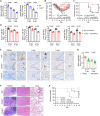CCR2 is a host entry receptor for severe fever with thrombocytopenia syndrome virus
- PMID: 37531422
- PMCID: PMC10396298
- DOI: 10.1126/sciadv.adg6856
CCR2 is a host entry receptor for severe fever with thrombocytopenia syndrome virus
Abstract
Severe fever with thrombocytopenia syndrome virus (SFTSV) is an emerging tick-borne bunyavirus causing a high fatality rate of up to 30%. To date, the receptor mediating SFTSV entry remained uncharacterized, hindering the understanding of disease pathogenesis. Here, C-C motif chemokine receptor 2 (CCR2) was identified as a host receptor for SFTSV based on a genome-wide CRISPR-Cas9 screen. Knockout of CCR2 substantially reduced viral binding and infection. CCR2 enhanced SFTSV binding through direct binding to SFTSV glycoprotein N (Gn), which is mediated by its N-terminal extracellular domain. Depletion of CCR2 in C57BL/6J mouse model attenuated SFTSV replication and pathogenesis. The peripheral blood primary monocytes from elderly individuals or subjects with underlying diabetes mellitus showed higher CCR2 surface expression and supported stronger binding and replication of SFTSV. Together, these data indicate that CCR2 is a host entry receptor for SFTSV infection and a novel target for developing anti-SFTSV therapeutics.
Figures






References
-
- X. J. Yu, M. F. Liang, S. Y. Zhang, Y. Liu, J. D. Li, Y. L. Sun, L. Zhang, Q. F. Zhang, V. L. Popov, C. Li, J. Qu, Q. Li, Y. P. Zhang, R. Hai, W. Wu, Q. Wang, F. X. Zhan, X. J. Wang, B. Kan, S. W. Wang, K. L. Wan, H. Q. Jing, J. X. Lu, W. W. Yin, H. Zhou, X. H. Guan, J. F. Liu, Z. Q. Bi, G. H. Liu, J. Ren, H. Wang, Z. Zhao, J. D. Song, J. R. He, T. Wan, J. S. Zhang, X. P. Fu, L. N. Sun, X. P. Dong, Z. J. Feng, W. Z. Yang, T. Hong, Y. Zhang, D. H. Walker, Y. Wang, D. X. Li, Fever with thrombocytopenia associated with a novel bunyavirus in China. N. Engl. J. Med. 364, 1523–1532 (2011). - PMC - PubMed
-
- T. Takahashi, K. Maeda, T. Suzuki, A. Ishido, T. Shigeoka, T. Tominaga, T. Kamei, M. Honda, D. Ninomiya, T. Sakai, T. Senba, S. Kaneyuki, S. Sakaguchi, A. Satoh, T. Hosokawa, Y. Kawabe, S. Kurihara, K. Izumikawa, S. Kohno, T. Azuma, K. Suemori, M. Yasukawa, T. Mizutani, T. Omatsu, Y. Katayama, M. Miyahara, M. Ijuin, K. Doi, M. Okuda, K. Umeki, T. Saito, K. Fukushima, K. Nakajima, T. Yoshikawa, H. Tani, S. Fukushi, A. Fukuma, M. Ogata, M. Shimojima, N. Nakajima, N. Nagata, H. Katano, H. Fukumoto, Y. Sato, H. Hasegawa, T. Yamagishi, K. Oishi, I. Kurane, S. Morikawa, M. Saijo, The first identification and retrospective study of severe fever with thrombocytopenia syndrome in Japan. J. Infect. Dis. 209, 816–827 (2014). - PMC - PubMed
-
- H. Li, Q. B. Lu, B. Xing, S. F. Zhang, K. Liu, J. Du, X. K. Li, N. Cui, Z. D. Yang, L. Y. Wang, J. G. Hu, W. C. Cao, W. Liu, Epidemiological and clinical features of laboratory-diagnosed severe fever with thrombocytopenia syndrome in China, 2011–17: A prospective observational study. Lancet Infect. Dis. 18, 1127–1137 (2018). - PubMed
MeSH terms
Substances
LinkOut - more resources
Full Text Sources
Molecular Biology Databases

